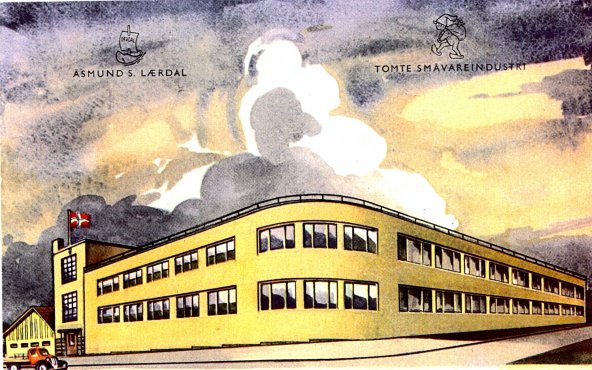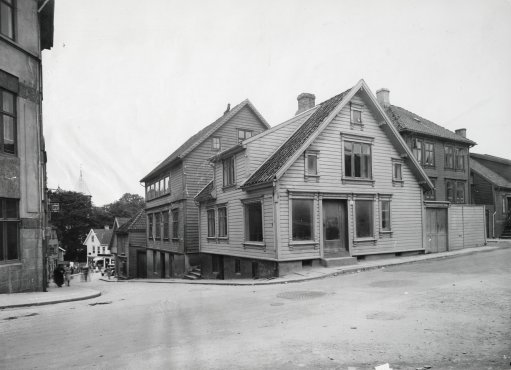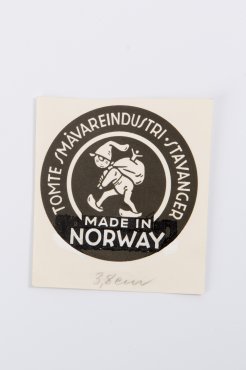Åsmund S. Lærdal forlag, Tomte Småvareindustri and Laerdal Medical
It all began when Åsmund Lærdal started a publishing house in 1940. The business quickly grew to be a toy factory in addition. The toys were produced under the name of Tomte småvareindustri.
Toys and Life-Saving
The picture books, the Anne dolls and the Tomte cars were amongst the most popular products. The company became the country's largest publisher of picture books, and the country's largest toy manufacturer, with impressive exports to many different countries.
Lærdal became an international pioneer for products in soft plastic. The company was the first in Europe to make soft plastic dolls. The Lærdal dolls and plastic figures came on the market from 1950. Solid knowledge of plastics was an important element in the transition from toys to life-saving equipment. In 1953, the same year that the first Anne doll was launched, the company was asked by the civil defence to make artificial wounds. With the Tomte cars, which came on the market in 1959, techniques were developed which could also be used in the production of these.
In the 1950s American doctors pointed out that thousands of lives could be saved if people learnt the technique of mouth-to-mouth resuscitation. Lærdal worked together with anaesthetists and researchers in Norway and the U.S.A. There were further developments in soft plastic technology and in the 1960s the life-saving doll «Resusci Anne». In the same year the Norwegian Savings Bank Association (den norske sparebankforeningen) donated 650 life-saving dolls to Norwegian schools. Life-saving using the mouth-to-mouth technique was taught in schools in Norway in the 1960s. In the course of that decade the company produced both the toy doll Anne and the life-saving Anne doll, as well as the Tomte cars.
In the history of the city of Stavanger the company is emphasised because they successfully managed to retool production for a new competitive situation. Thomas Bjelland began working in the company in 1967, the same year that toy doll production ceased. He remembers his last order of dolls being sent to Eastern Europe in the autumn of 1967, and the competition from countries with lower production costs. The demand for Tomte cars, however, was still considerable, even when the company ceased production of toys in 1978. The emphasis of the company from then on was life-saving. Today the company is called Lærdal Medical. When Åsmund Lærdal died in 1981, at the age of 68, his son Tore Lærdal (b. 1952) took over the company.
The UN's Millennial Goal
In 2010 Laerdal Medical was asked to develop a training program with the UN for health workers in Africa. The goals of the program, which are ranked as numbers 5 and 6 in the UN's Millennial Goals, are to reduce infant deaths and deaths in childbirth. Today, in 2013, Lærdal and its daughter company Laerdal Global Health are developing life-saving equipment and providing training for midwives in Africa, India and Bangladesh. In September 2013 a report was presented for the UN on the ten most important innovations. Among these was the invention «Helping Babies Breathe».
«The goal is to have trained and equipped one million midwives during 2015, so that at least 100 000 lives per year can be saved».
Tore Lærdal to Stavanger Aftenblad 24th. September 2013
From rented premises in Hetlandsgate to a factory in Tanke Svilandsgate From 1940 until 1948 the company occupied rented premises in 4, Hetlandsgate, Steinkargaten, Banegaten and the upper floor in 16, Støberigaten. In 1944 Lærdal had to vacate the premises at short notice when German troops were going to use the premises for casting boats for an invasion of England. In 1948 the factory moved in to Tanke Svilandsgate where they continue today (2013). «On the ground floor are the offices and the workshop for toys, and on the upper floor there is the assembly department for toys and the paper department» (Kleven 1989).
Experimenting with soft plastic at home in the kitchen
Not long after the company had moved in to the new premises, they started experimenting with plastic mixtures and moulding techniques. This had to be kept secret. A shed was used that belonged to the factory in Tanke Svilandsgate. For a period of about six months in 1949, Åsmund Lærdal also experimented at home in the kitchen. His son Åge (b. 1946) can remember the dolls exposed to the sun in the windows in the big children's room.
Astrid, (b. 1943), the eldest child in the family, remembers:«There was a particular tension in the air. Dad's experimenting had to be a secret within the family. Dad struggled with lumps of plastic, moulds and temperatures in the oven. First the trial pieces were placed in the afternoon sun in the kitchen windows. I won't say the smell was nauseating, but it was very special. After a time they were moved to the corner window in the children's room upstairs because there were so many of them, and there was more sunlight. Both young and old in the family were concerned that the trial pieces should not become discoloured, becoming either paler, grey or blue. We children understood that it was important that not too much time should elapse before Dad's experiments succeeded. We were happy and relieved when the bath duck and Tassen could be made at the factory because they kept the good yellow colour. When Wonder Baby's face and hands could also be mass-produced for sale in shops without the risk of discolouration, this had to be immortalized by a professional photographer. Wonder Baby was proof that Dad had reached a new level as a toy manufacturer. The clog could sail into a whole new dolls' world...»
The Clog and Tomte
The company's first trademark was a clog with a mast and sail. The motto was Happiness for children. Along with the wooden toys there was the figure of the gnome Tomte, and the name Tomte Småvareindustri.
When production of wooden toys started up again after the Second World War, there was a shortage of goods. Facilities for production were not good either. At the start the quality was so poor that the company chose to market the toys under another name: Tomte småvareindustri. As the wooden toys were gradually improved, the name became a stamp of quality (Kleven 1989).
With the emphasis on life-saving in 1960, the company chose a new logo based on the story of the Good Samaritan. At the same time the figure of the Tomte gnome continued to characterize the Anne dolls and the Tomte cars out in the world. In the exhibition, Tomte is your guide through the history of the factory as a toy manufacturer.
Written by Hege Stormark, Norwegian Children's Museum and Stavanger School Museum/ MUST
Translated by Piers Crocker
Sources:
Kleven, Henning, unpublished manuscript about the history of Lærdals, 1989
Roalkvam, Gunnar and Øye, Kristin, Stavanger bys historie, volume 4: "Oljebyen 1965-2010, Wigestrand forlag, 2012
Conversation with Thomas Bjelland and Johan Gramstad 2nd. September 2013
Conversation with Astrid Lærdal Frøseth 24th. August 2013
Conversation with Åge Lærdal 26th. August 2013
Stavanger Aftenblad 24th. September 2013
Tjomsland, Nina, Hjertet i arbeidet. Lærdals første 50 år, 1990


